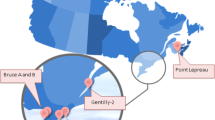Abstract
Nuclear power raises a number of fundamental environmental issues. The main problem is how to deal with the quantities of highly radioactive wastes which are produced from nuclear power plants. Discharges from nuclear power plant can cause substantial climatic contamination danger and hazard for individuals’ lives and well-being. In this chapter, different techniques for modelling and control of hazards have been presented. The modelling is in view of recreation and perception of spreading of air pollutants, estimation of the source term for atomic and compound fiascos, and the hazard appraisal of unsafe substances. This chapter will include the principle of modelling the nuclear and chemical disasters, optimal control of theoretical frame with example, various modelling techniques, challenges associated with measurement of pollutants, etc. Finally, solution and recommendation of good model will be presented. The inclusion of related references provides a starting point for the interested reader/researchers/industrialists.
Similar content being viewed by others
References
Lamarsh J (1975) Introduction to nuclear engineering. Addison-Wesley, NY
de Sampaio AB, Junior MA, Lapa CM (2008) A CFD approach to the atmospheric dispersion of radionuclides in the vicinity of NPPs. Nucl Eng Des 238:250–273
Liu F, Huang SX (2011) Optimization theories and applications for atmospheric environmental risk control. Beijing: China Meteorological Press.
Holmes N, Morawska L (2006) A review of dispersion modelling and its application to the dispersion of particles: an overview of different dispersion models available. Atmos Environ 40(30):5902–5928
Gurjar B (2008) Air pollution: health and environmental impacts. CRC
Zheng D, Leung J, Lee B, Lam H (2007) Data assimilation in the atmospheric dispersion model for nuclear accident assessments. Atmos Environ 41(11):2438–2446
Nakayama H, Nagai H (2009) Development of local-scale high-resolution atmospheric dispersion model using large-eddy simulation part 1: turbulent flow and plume dispersion over a flat terrain. J Nucl Sci Technol 46:1170–1177
Punitha G, Sudha AJ, Kasinathan N, Rajan M (2008) Atmospheric dispersion of sodium aerosol due to a sodium leak in a fast breeder reactor complex. J Power Energy Sys 2:889–898
Vach M, Duong VM (2011) Numerical modeling of flow fields and dispersion of passive pollutants in the vicinity of the temelin nuclear power plant. Environ Model Assess 16:135–143
Gallego E, Barbero R, Cuadra D, Domingo J, Iranzo A (2010) Modelling with a CFD code the nearrange dispersion of particles unexpectedly released from a nuclear power plant. In: proceedings 3rd European IRPA Congress (Helsinki), pp 14–18
Raza S, Avila R (2001) A 3D lagrangian particle model for direct plume gamma dose rate calculations. Radiol Prot 21:145–154
Xie D, Wang H, Kearfott KJ (2012) Modeling and experimental validation of the dispersion of 222Rn released from a uranium mine ventilation shaft. J Atmos Environ 60:453–459
Xie D, Wang H, Kearfott KJ, Liu Z, Mo S (2014) Radon dispersion modeling and dose assessment for uranium mine ventilation shaft exhausts under neutral atmospheric stability. J Environ Radioact 129:57–62
Duarte JP, Frutuoso e Melo PFF, Alves ASM, dos Passos EM (2013) Atmospheric dispersion and dose evaluation due to the fall of a radioactive package at a LILW facility. Int J Energy Eng, 3(3):119–126 doi:10.5923/j.ijee.20130303.01
Fuka V, Brechler J (2012) Large eddy simulation modelling of the dispersion of radioactive particulate matter. Int J Environ Pollut 48:156–163
Nakayama H, Jurcakova K, Nagai H (2013) Development of local-scale high-resolution atmospheric dispersion model using large-eddy simulation. Part 3: turbulent flow and plume dispersion in building arrays. J Nucl Sci Technol 50:503–519
Shunxiang H, Feng L, Qingcun Z, Fei H, Jiang Z, Zifa W (2015) Modeling and optimal control of atmospheric pollution hazard in nuclear and chemical disasters. Procedia IUTAM 17:79–90
Raskob W, Ehrhardt J (2007) Status of the RODOS system for off-site emergency management after nuclear and radiological accidents. In: The first international conference on risk analysis and crisis response
Atomic Energy Regulatory Board (AERB) (2008) Atmospheric dispersion and modelling, Guide No. AERB/NF/SG/S-1
Vervecken L, Camps J, Meyers J (2015) Dynamic dose assessment by large eddy simulation of the near-range atmospheric dispersion. Published in J Radiol Prot 35:165–178. doi:10.1088/0952-4746/35/1/165
Leelossy Á, Molnár F, Izsák F, Havasi Á, Lagzi I, Mészáros R (2014) Dispersion modeling of air pollutants in the atmosphere: a review. Central Eur J Geosci 6(3):257–278. doi:10.2478/s13533-012-0188-6
Lewis EE (1977) Nuclear power reactor safety. Wiley, NY
Author information
Authors and Affiliations
Corresponding author
Editor information
Editors and Affiliations
Rights and permissions
Copyright information
© 2018 Springer Nature Singapore Pte Ltd.
About this chapter
Cite this chapter
Verma, S.K., Sinha, S.L., Chandraker, D.K. (2018). An Overview of Current Knowledge Concerning the Environmental Consequences of the Nuclear Pollution: Sources, Effects and Control. In: Sharma, N., Agarwal, A., Eastwood, P., Gupta, T., Singh, A. (eds) Air Pollution and Control. Energy, Environment, and Sustainability. Springer, Singapore. https://doi.org/10.1007/978-981-10-7185-0_13
Download citation
DOI: https://doi.org/10.1007/978-981-10-7185-0_13
Published:
Publisher Name: Springer, Singapore
Print ISBN: 978-981-10-7184-3
Online ISBN: 978-981-10-7185-0
eBook Packages: Earth and Environmental ScienceEarth and Environmental Science (R0)




